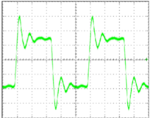knark
Junior Member level 1
Hello everyone!
I am trying to model a differential transmission model for my lvds application. I first found out that for visual applications ribbon cable is the one commonly used for small distances upto 0.5m. I looked up the spec, dimensions and dielectric properties of the ribbon cable and modeled it using the strip line model of mtline. For a single pair of ribbon cable i used four conductors by grounding the two conductors at each side. I have attached the lmg gui for the modeled mtline for ribbon cable.
The response of my system is quite good and idealistic, which is bothering me. It has no overshoots and no ringing effect. System is perfectly damped. I have attached the AC analysis graph. I am expecting an output which can show me some overshoot, some non-ideality, some effect of the line inductance. But all i am getting is a perfectly damped response. With increase in frequency the resistive drop increase due to skin effect but the signal still remains overly damped with no overshoots. Can anybody help me sort out what thread in modelling i am missing over here?
https://obrazki.elektroda.pl/1719759200_1397494162.png
https://obrazki.elektroda.pl/7996752300_1397494162.png


I am trying to model a differential transmission model for my lvds application. I first found out that for visual applications ribbon cable is the one commonly used for small distances upto 0.5m. I looked up the spec, dimensions and dielectric properties of the ribbon cable and modeled it using the strip line model of mtline. For a single pair of ribbon cable i used four conductors by grounding the two conductors at each side. I have attached the lmg gui for the modeled mtline for ribbon cable.
The response of my system is quite good and idealistic, which is bothering me. It has no overshoots and no ringing effect. System is perfectly damped. I have attached the AC analysis graph. I am expecting an output which can show me some overshoot, some non-ideality, some effect of the line inductance. But all i am getting is a perfectly damped response. With increase in frequency the resistive drop increase due to skin effect but the signal still remains overly damped with no overshoots. Can anybody help me sort out what thread in modelling i am missing over here?
https://obrazki.elektroda.pl/1719759200_1397494162.png
https://obrazki.elektroda.pl/7996752300_1397494162.png




